On the brink of new battle: Frontline perspectives before winter and possible gray zone expansion
 Photo: Battles for Selydove and Kurakhove are likely to begin in the coming weeks at the front (facebook.com/Ministry_of_Defence_UA)
Photo: Battles for Selydove and Kurakhove are likely to begin in the coming weeks at the front (facebook.com/Ministry_of_Defence_UA)
Russian forces continue to intensify pressure in the Donbas. The enemy is approaching Kurakhove, aiming to encircle Selydove, and appears to be bogged down in fighting for Toretsk.
For details on the situation on the eastern front, other areas, and whether Russia is capable of a sudden breakthrough before winter, read the full report by RBC-Ukraine.
Contents
- Is Selydove being surrounded? What will happen to the garrison?
- Battle for Toretsk could drag on
- When might the battle for Kurakhove begin?
- Why is evacuation from Kupiansk necessary?
- New challenges in the Kursk region
- Is Russia capable of suddenly breaking through the front line?
Is Selydove being surrounded? What will happen to the garrison?
The Pokrovsk direction remains one of the hottest spots. Over the past day, Ukraine's defense forces stopped 26 assaults, with the highest concentration of enemy attacks near Selydove. Russian war reporters claim that troops have entered the territory of the concrete structures plant on the eastern outskirts of Selydove, but there is no visual confirmation.
The enemy is advancing more slowly than a month ago, as Ukrainian forces managed to disrupt their offensive pace. However, according to soldier Stanislav Buniatov, who runs the Hovoryat Snaiper Telegram channel, the Russian troops are gradually flanking Selydove and tightening the noose.
"Sometimes they slip through on the outskirts, and for now, it's a one-way road for them, but things could change over time," he wrote.
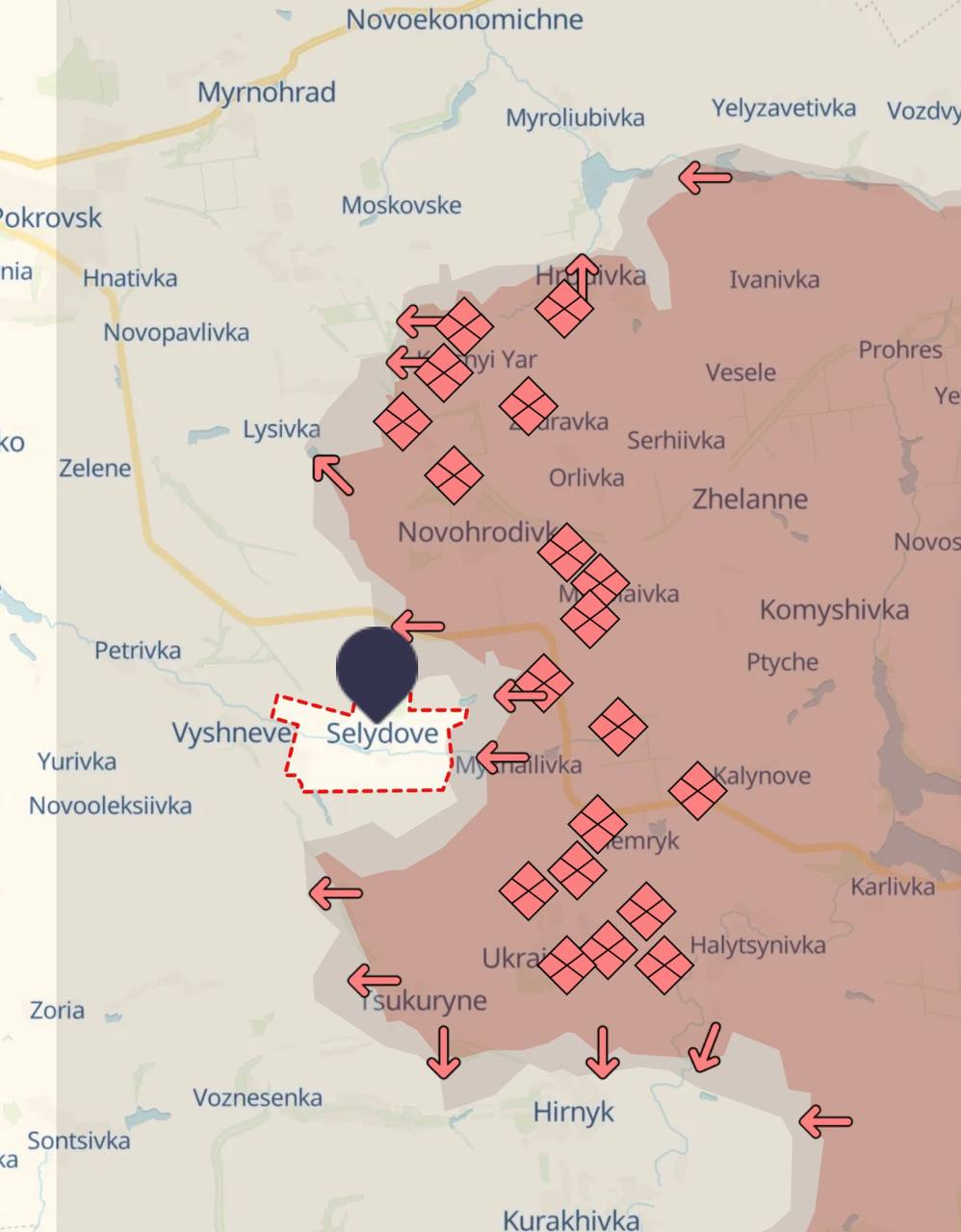
Photo: Russian forces are encircling Selydove from the north and south (deepstatemap.live)
German BILD expert Julian Röpcke claims that Selydove is now encircled. The defense in this area is held by the Kara-Dag 15th National Guard Brigade, but due to active enemy actions, it’s possible that the city may have to be abandoned.
"So the town will fall, no matter its strong defenders. Exactly what I experienced when I visited Kara Dag in the area, 4 weeks ago," he said.
Selydove is constantly under fire and almost destroyed, making it very difficult to hold the defense. The gray zone is just two kilometers away, which means that Russian forward units can already directly enter the city, explains military expert and reserve major of the Armed Forces of Ukraine, Oleksii Hetman.
"When the walls shake, you cannot hold the defense. Considering the distance between the flanks is approximately 6 km, Selydove will likely have to be abandoned," he suggests.
Regarding Pokrovsk, rapid advances and encirclement are, firstly, unlikely, and secondly, autumn mud will complicate the offensive. Most likely, in the coming weeks, the battle will focus on roads, infantry assaults will decrease, but artillery fire, drone attacks, and airstrikes will intensify, added Hetman.
Battle for Toretsk could drag on
The Russian army is advancing near Toretsk and within the city itself. The offensive continues near New York, Dachne, and Shcherbynivka, to the south, northeast, and west of Toretsk, respectively.
Vasyl Chinchyk, the head of the city military administration, says that around 40-50% of the city remains under the control of the Defense Forces. According to the spokesperson for the Luhansk operational-tactical group, Anastasia Bobrovnykova, the enemy has entrenched itself in the eastern part, on Central Street and several streets further south.
Military serviceman Yevhen Ievlev, whose unit is defending just south of Toretsk, told RBC-Ukraine that every square meter costs the Russians dearly. "In terms of dynamics and speed, these are no longer the advances we saw a month and a half or two months ago when the enemy could make certain gains of up to a kilometer in a day," he emphasized.
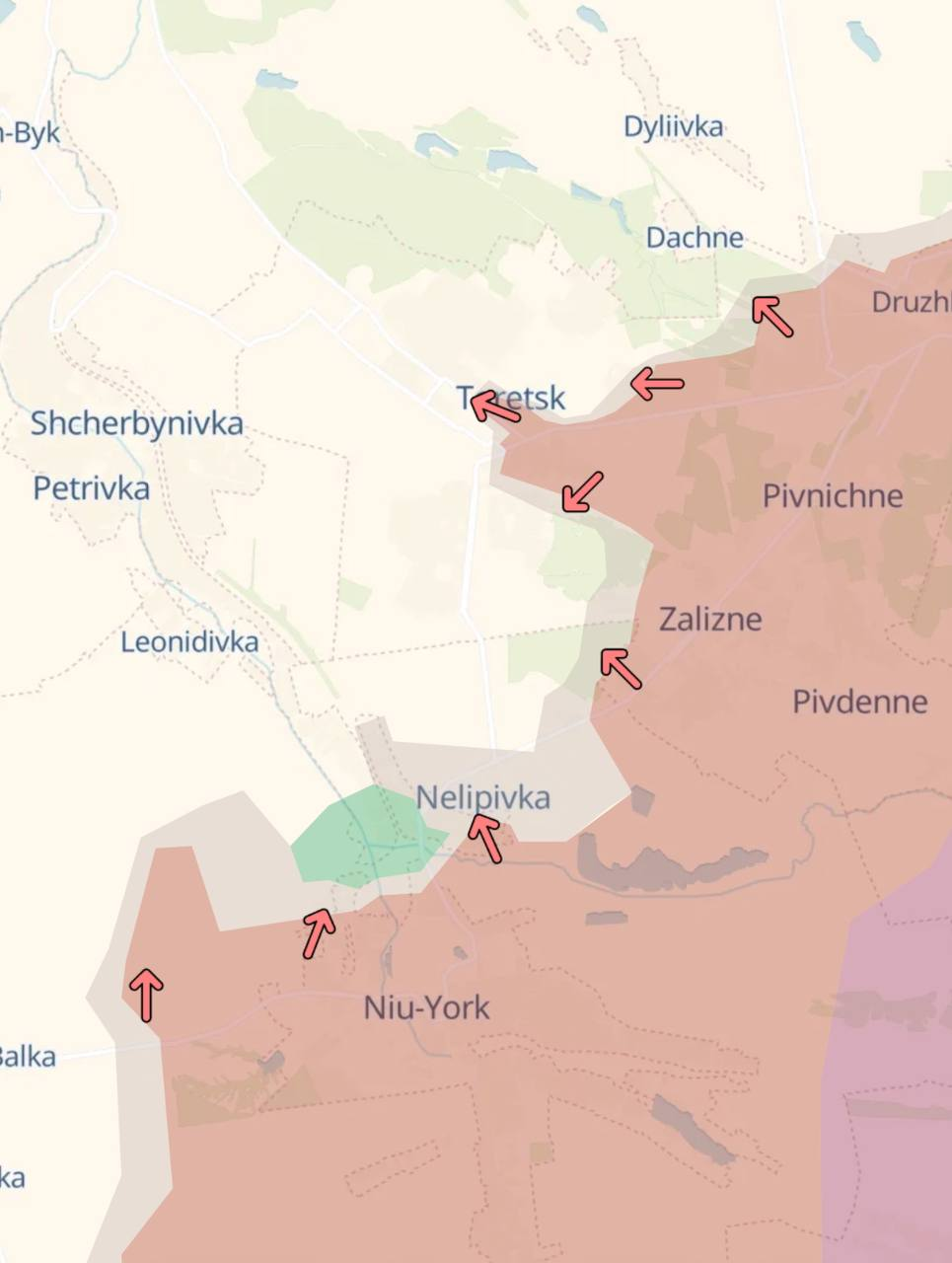
Photo: the enemy is bogged down in the battle for Toretsk (deepstatemap.live)
Unlike in Selydove, Toretsk still has intact buildings. The city is slightly larger, and fighting in the urban area could drag on for months, explains Hetman.
"Urban combat can take place on three levels. Conditioned by the asphalt, on the floors, and in underground utilities. Given that Russian troops are stationed in the east of Toretsk, it's unlikely they will shell themselves. And as long as it remains undestroyed, like other cities, they will take a long time to capture it," said the source.
When might the battle for Kurakhove begin?
After the Russian forces encountered head-on resistance in their assault on Pokrovsk, they regrouped and are now focusing on the Kurakhove direction. According to reports, the Defensive Forces repelled 40 attacks in the past day here.
After capturing Vuhledar, the enemy is advancing northeast near Kostiantynivka, Antonivka, Katerynivka, and Vodiane, as well as northwest in the Bohoyavlenka area. Judging by DeepState maps, they have taken Ostrovske and are now within 3.5 km of the city. Their goal is to approach Kurakhove from the south and east.
For their attacks, the Russian troops are using equipment to penetrate as far as possible in open areas before the dirt roads become impassable. Likely following old tactics, they are focusing on trying to encircle the city.
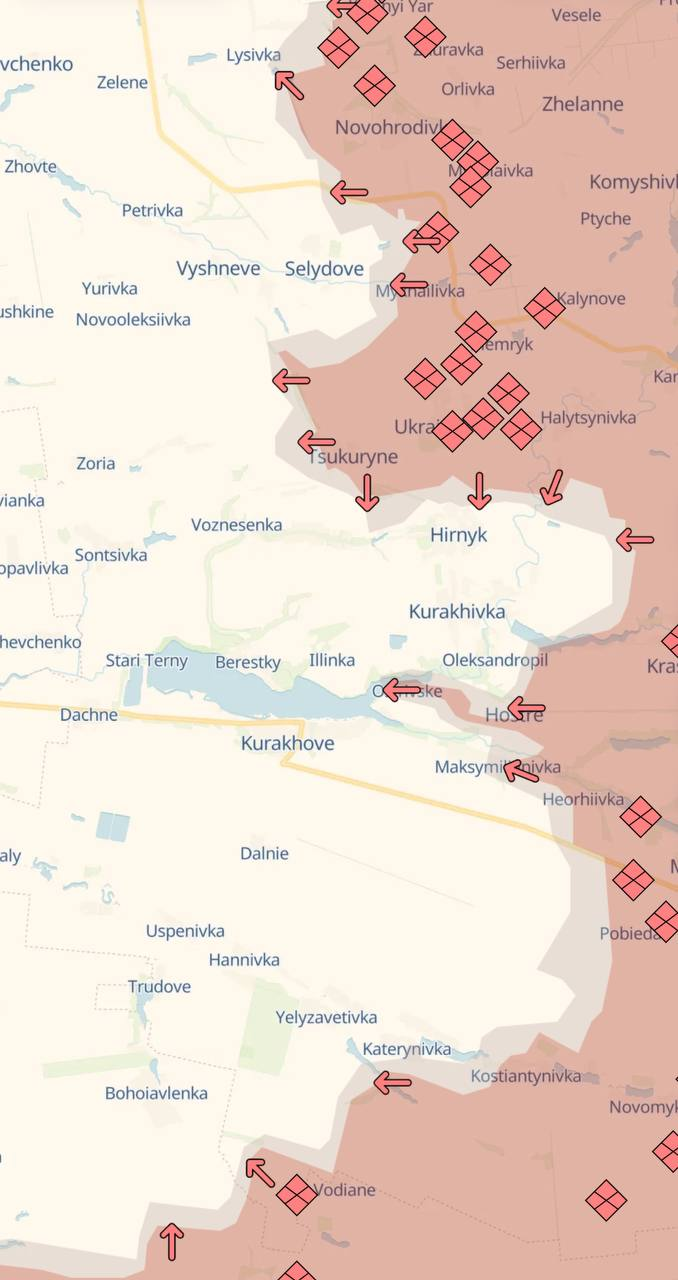
Photo: the battle for Kurakhove could begin in the coming weeks (deepstatemap.live)
"Some experts say that the battle for Kurakhove may begin in the coming weeks, and I agree with that. From a military standpoint, the tactic is quite clear: the enemy is trying to attack from a different direction if their initial attempts fail. We’ve done the same. Will we be able to hold out or not? It's hard to say. For the Defense Forces to succeed, we need more equipment, personnel, and weapons,” Hetman noted.
It’s worth mentioning that recently, just westward, the enemy advanced about a kilometer in the areas around Huliaipole and Velyka Novosilka, near the administrative border between the Zaporizhzhia and Donetsk regions. The apparent intention is to reach the road to Zaporizhzhia and try to cut off the Kurakhove garrison. However, according to the Institute for the Study of War (ISW), the enemy's tactical successes do not yet appear to be part of a large-scale effort.
Why is evacuation from Kupiansk necessary?
The situation remains tense near Kupiansk in the Kharkiv region. Over the past day, 28 enemy attacks were recorded, with the Defense Forces repelling assaults around ten settlements. Overall, the Kupiansk direction is now among the top three most active hotspots.
The offensive operation is advancing along the Kupiansk-Svatove-Kreminna line. Geolocated footage indicates Russian advances southeast of the district center. Additionally, analysts are warning of a potential threat to the road leading to Borova near Kruhliakivka.
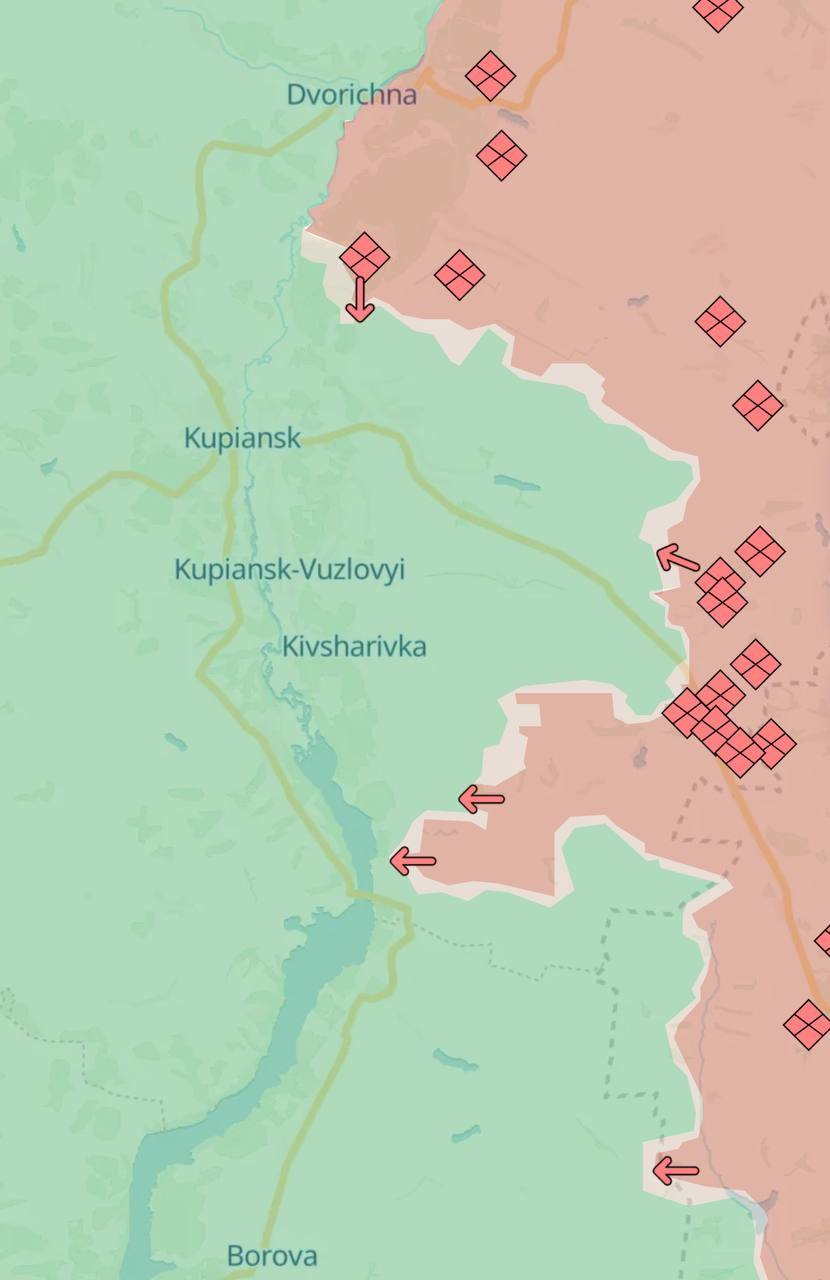
Photo: due to the worsening military situation, civilians are being evacuated from Kupiansk and frontline communities (deepstatemap.live)
The day before, the head of the regional military administration, Oleh Syniehubov, reported a worsening military situation ahead of the heating season. He stated that it is impossible to guarantee electricity, heating, and water supply on the left bank of the Oskil River. In light of this, the local Defense Council announced the evacuation of civilians from Kupiansk and three other frontline communities, including Borova.
According to Hetman, residents of areas at least 10 km from the frontline should be evacuated, as this distance is within the range of artillery fire, and settlements are suffering from heavy shelling.
"We need to evacuate people to avoid endangering them and to give our troops a chance to hold the defense. It's hard to fight when there are many civilians. Secondly, nothing is functioning there — no stores, no pharmacies. All medical and food supplies are the military's responsibility. And soon, there will be the additional challenge of heating," he told RBC-Ukraine.
New challenges in the Kursk region
Last week, the Russian forces launched the second phase of their counteroffensive in the Kursk region. Initially, they attacked with a large force, breaking through approximately 5 km into the territory held by the Defensive Forces.
The main strikes were directed toward the administrative border of the Korenevo and Sudzha districts. Commander of the Chechen special forces Akhmat, Apti Alaudinov, stated that the primary goal in the Kursk region is to "lure" Ukrainian troops into an encirclement and destroy them.
Currently, heavy fighting continues. The Ukrainian Armed Forces have managed to regain control of some positions, although certain areas may remain in a vulnerable situation. "There were attempts by Russia to push back our positions, but we are holding certain lines," emphasized President Volodymyr Zelenskyy.
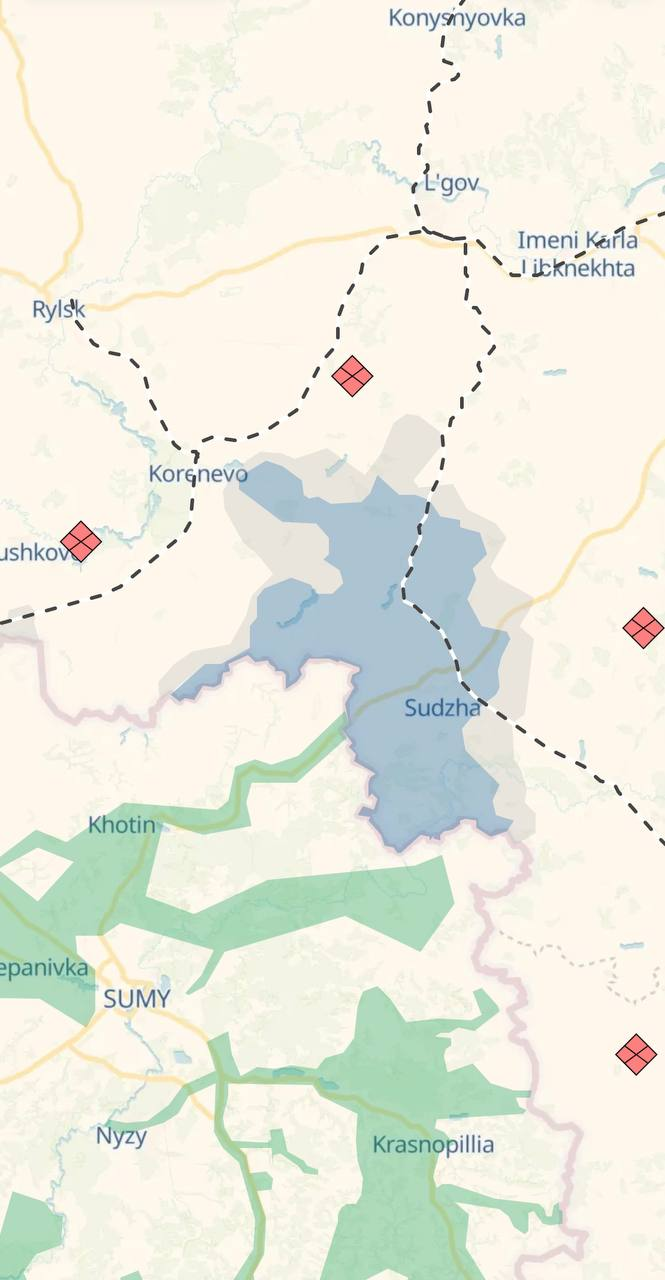
Photo: Russian forces have launched the second phase of their counteroffensive and are attempting to push the Ukrainian Armed Forces out of the Kursk region (deepstatemap.live)
Russian President Vladimir Putin had ordered the Ukrainian Armed Forces to be pushed out of the Kursk region by October 1, but as we near November 1, Ukrainian forces remain there, an expert notes. Nonetheless, there is always the possibility that at some point the enemy will make further efforts to capture areas still out of their control.
"However, our goal was never to hold territories and positions the same way we do on the eastern front. We avoid frontal clashes with Russian forces, as there is no sense in fighting head-on with numerically superior forces," Hetman explained.
What has been achieved so far is that the Defense Forces have forced Russia to keep up to 50,000 soldiers, who were pulled from some "secret reserves," according to the expert. He also doubts this claim, as Russia is already using as much of its manpower as possible. Therefore, if there are more troops in the Kursk region, there are likely fewer on other fronts.
This is probably why rumors have surfaced about North Korean soldiers being involved. Sources in the Ukrainian Defense Forces say that 10,000 North Korean soldiers are currently being trained in the Far East, with the potential to be deployed to border areas or used for rotation. Other reports suggest the formation of a special Buryat battalion with 3,000 North Korean soldiers.
The battalion is currently being supplied with firearms and ammunition, and it will likely be tasked with combat missions near Sudzha and Kursk. Speculation has also emerged that some North Korean troops might be sent to the front in Ukraine. Hetman, however, is skeptical, suggesting that Moscow is unlikely to use them outside of Russia for now, to avoid international backlash and prevent giving Western partners of Ukraine a reason to increase support.
"How dangerous is this? Of course, it's dangerous. There’s talk of at least 10,000 troops. But I believe that if they do appear on the front lines, they will be involved in auxiliary tasks rather than direct combat," the expert said.
Is Russia capable of suddenly breaking through the front line?
As the cold weather approaches, it seems that the Russian troops are not making significant preparations for winter on the front. Instead, they aim to achieve as many objectives as possible before the frost sets in. "They are trying to make the most of the dry weather currently in Donetsk," noted a spokesperson for the Luhansk Operational-tactical group, Anastasia Bobrovnykova.
Russian forces will push as much as their strength allows, agrees Hetman. However, due to weather conditions, they may reduce the intensity of ground operations, while increasing aerial attacks to maintain momentum.
"There is information that the resources for offensive operations have nearly been exhausted after six months of fighting. Not human resources, but overall resources. Simply adding more troops cannot increase offensive capabilities. They would need to stop and re-prepare, as they did before," he emphasized.
As for the possibility of unexpected strikes to break through the front at a specific location, the likelihood is close to zero.
"How can the enemy break through the front when they have nothing to do so with? When our Kursk operation began, they immediately pulled troops from the Kharkiv direction. Now they're talking about North Koreans. If they had reserves, why would they pull troops from the front? If they had to do all of this just to stop our advance, it means they simply have nothing to cover the Kursk section. Therefore, I don't see any preconditions for a breakthrough. The Russians don't have the resources for this, otherwise, they would have used them," concluded the expert.
Sources: reports from the General Staff of the Armed Forces of Ukraine, analysis from the Institute for the Study of War (ISW), DeepState maps, statements from military spokespeople and local authorities, as well as comments from military expert Oleksii Hetman.

